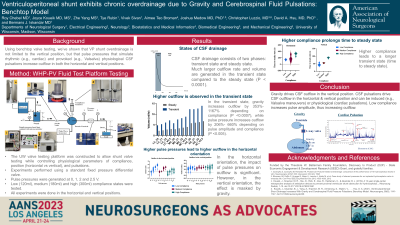Ventriculoperitoneal shunt exhibit chronic overdrainage with Gravity and Cerebrospinal Fluid pulsations: benchtop model
Ventriculoperitoneal Shunt Exhibit Chronic Overdrainage with Gravity and Cerebrospinal Fluid Pulsations: Benchtop Model
Friday, April 21, 2023


Roy Chebel, MD (he/him/his)
Research Associate
UW-Madison
Madison, Wisconsin, United States
ePoster Presenter(s)
Introduction: Using benchtop valve testing, we’ve shown that VP shunt overdrainage is not limited to the vertical position, but that pulse pressures that simulate rhythmic (e.g., cardiac) and provoked (e.g., Valsalva) physiological CSF pulsations increase outflow in both the horizontal and vertical positions. The present study examines the temporal and physiological characteristics of flow perturbations through a medium pressure differential shunt valve.
Methods: The previously developed pseudo-ventricle (PV) benchtop valve testing platform comprises a rigid pseudo-ventricle, compliance chamber, pulse generator, and pressure sensors. The PV was used to measure flow rates through a differential pressure shunt valve over 15 minutes under the following simulated physiological conditions: orientation (horizontal/vertical), compliance (low/medium/high), and pulsation generator force (none/low/medium/high).
Results: Two phases of CSF drainage were identified: a transient state and a steady state. The steady state is the ideal state for a shunt, and what valves aim to achieve. A transient state is created with every change in gravity or pulse pressure. A much larger outflow rate is generated in the transient state compared to the steady state (P < 0.0001). In the transient state, gravity increased outflow by 353%-1167% depending on compliance (P < 0.0007), while pulsations increased outflow by 206%- 660% depending on pulse amplitude and compliance (P < 0.005).
Conclusion : As long as shunt valves are subjected to gravity and pulse pressures, a steady state may not be reached, leading to repetitive bursts of high CSF outflow. Existing commercial valves are not designed to control these conditions, likely leading to a chronic state of shunt overdrainage.
Methods: The previously developed pseudo-ventricle (PV) benchtop valve testing platform comprises a rigid pseudo-ventricle, compliance chamber, pulse generator, and pressure sensors. The PV was used to measure flow rates through a differential pressure shunt valve over 15 minutes under the following simulated physiological conditions: orientation (horizontal/vertical), compliance (low/medium/high), and pulsation generator force (none/low/medium/high).
Results: Two phases of CSF drainage were identified: a transient state and a steady state. The steady state is the ideal state for a shunt, and what valves aim to achieve. A transient state is created with every change in gravity or pulse pressure. A much larger outflow rate is generated in the transient state compared to the steady state (P < 0.0001). In the transient state, gravity increased outflow by 353%-1167% depending on compliance (P < 0.0007), while pulsations increased outflow by 206%- 660% depending on pulse amplitude and compliance (P < 0.005).
Conclusion : As long as shunt valves are subjected to gravity and pulse pressures, a steady state may not be reached, leading to repetitive bursts of high CSF outflow. Existing commercial valves are not designed to control these conditions, likely leading to a chronic state of shunt overdrainage.
